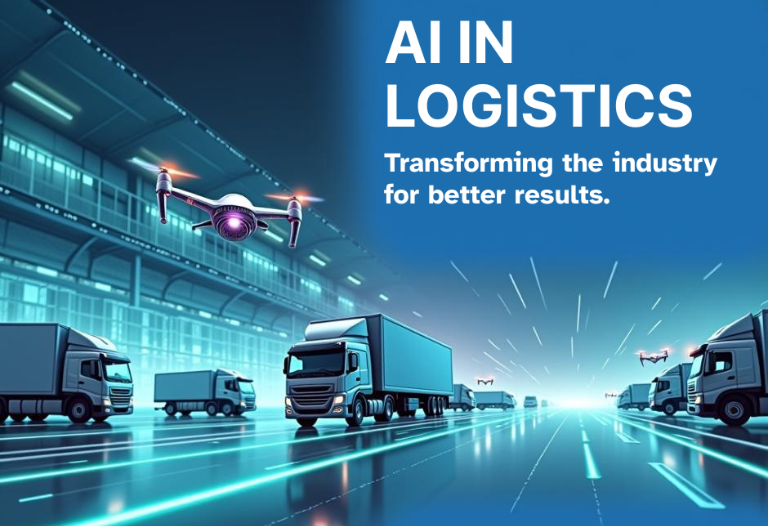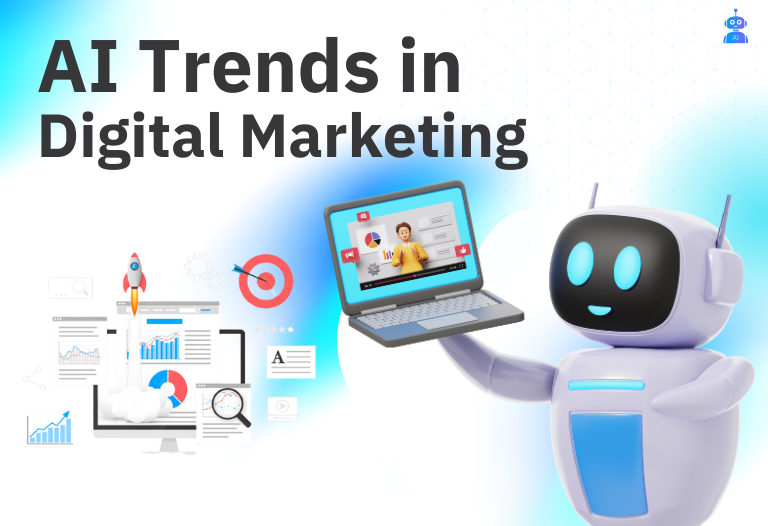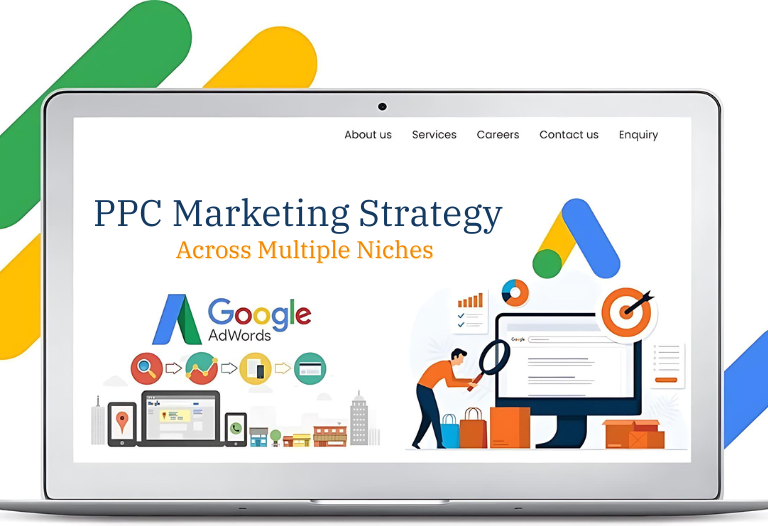
Today’s logistics industry is under immense pressure: deliver faster, cheaper, and more efficiently — or get left behind. Traditional supply chain models are simply not built for this pace, and with AI in logistics, what the industry needs isn’t just a tweak here and there, instead it needs a complete renovation.
AI Is No Longer Optional — It’s Inevitable
According to Meticulous Research, the global AI-in-supply-chain market is expected to hit $58.55 billion by 2031, growing at a massive CAGR of 40.4% starting from 2024. That’s not just impressive; it’s a clear signal that AI is becoming the cornerstone of modern logistics.
This proves that AI isn’t just nice-to-have anymore. It’s already topping the priority list for logistics companies looking to stay competitive, cut costs, and future-proof their operations.
Cracking the Code: What AI Does in Logistics
Artificial Intelligence reinvents the brains behind the next generation of logistics. Fueled by big data, AI learns from massive volumes of information gathered across logistics operations. It gets to work by automating tasks, optimizing decisions, and cutting unnecessary costs across the board.
And the results? They speak for themselves.
According to McKinsey, companies that moved fast on AI-driven supply chain management saw:
- 15% lower operational costs
- 35% reduction in inventory levels
- 65% boost in service levels
That’s not a gentle improvement — that’s a leap forward.
What AI Gets Right — And Why It Matters
Let’s break down some of the biggest wins AI delivered in logistics:
- Fewer Forecasting Errors: AI-powered predictive analytics can cut supply chain forecasting errors by 20–50% — helping businesses plan better and respond faster.
- Lean Warehousing: By integrating AI in logistics, warehouse costs will shrink by 5–10%, and admin expenses will drop by 25–40%.
- Smarter Routes, Faster Deliveries: AI helps optimize real-time routes, reducing delays and speeding up fulfillment.
- Better Inventory Control: AI takes the guesswork out of stock levels, keeping supply in stock without overordering.
- More Automation, Less Repetition: Manual tasks get offloaded to machines, freeing up employees for more strategic, human-focused work.
- Next-Level Customer Experience: With AI ensuring smoother delivery and fewer errors, customer satisfaction naturally climbs.
Bonus Effect: AI in Logistics Is Powering Manufacturing Too
The ripple effect doesn’t stop at logistics. AI-powered supply chains are feeding real-time insights into manufacturing, helping factories:
- Avoid material shortages
- Lower storage costs
- Fine-tune inventory in sync with demand
It’s not just about moving things faster — it’s about making more intelligent decisions, every step of the way.
Game-Changing Advantages You Can’t Ignore
AI isn’t just a “nice to have” in logistics anymore — it’s becoming the beating heart of smarter, faster, and greener operations. From automating grunt work to slashing operational costs, here’s how integrating AI reshapes the industry.
1. Automation That Works Around the Clock
Forget repetitive, time-consuming tasks because AI is built to handle them. With robotic process automation (RPA) and intelligent AI systems, logistics teams can automate workflows once handled manually.
📊 According to Statista, 60% of global companies expect RPA to revolutionize supply chains by 2025.
Here’s what that looks like on the ground:
- Inventory Control: AI-powered bots track stock levels, flag shortages, and even auto-order supplies before you know you’re running low.
- Smarter Warehousing: Robots pick, pack, and transport goods — optimizing storage layouts for speed and accessibility.
- Instant Quality Checks: Vision-based AI inspects processes and products, reducing errors and catching issues early.
- Predictive Maintenance: Sensors monitor machinery health 24/7, flagging potential breakdowns before they hit the bottom line.
2. Cutting Costs Without Cutting Corners
Streamlining operations means trimming the fat — and AI knows exactly where to cut.
According to McKinsey’s global survey, 44% of executives who implemented AI said it directly reduced costs. Here’s how:
- Route Optimization: AI maps the most fuel-efficient delivery paths using traffic data, weather forecasts, and road conditions.
- Smart Maintenance: Vehicle sensors predict breakdowns before they happen, reducing downtime and expensive repairs.
- Demand-Driven Supply: AI digs into historical data and buying trends to help you restock what’s needed, not what’s guessed.
- Error Reduction: Automating manual, error-prone tasks means fewer costly mistakes — and more reliable service.
3. Greener Logistics
Logistics isn’t carbon-neutral. But AI is helping companies clean up their act.
Accenture says AI-powered analytics can significantly reduce greenhouse gas emissions by optimizing the entire supply chain.
Here’s how companies are making sustainability part of the plan:
- Forecasting Demand Smartly: AI minimizes unnecessary trips by stocking the right amount.
- Dodging Disruptions: AI predicts weather-related delays and suggests real-time alternate routes.
- Stopping Extra Shipments: Accurate forecasts reduce the need for last-minute, fuel-guzzling deliveries.
Sustainability isn’t just good PR — it’s becoming a strategic advantage.
4. Customer Experience That Feels Like Magic
Want to keep customers coming back? Give them what they want — speed, transparency, and smart support.
With NLP (Natural Language Processing) and machine learning, AI makes logistics more responsive and personal.
Here’s what it delivers:
- Real-Time Tracking: Accurate ETAs keep customers in the loop from dispatch to doorstep.
- Instant Alerts: Proactive notifications if delays or disruptions are detected.
- Predictive Support: AI anticipates issues based on past shipment data — and often fixes them before the customer knows.
Plus, 24/7 chatbots handle routine questions, freeing up human reps for complex cases.
5. Smarter Schedules, Happier Teams
AI doesn’t replace your workforce — it makes them better. It helps build fair, efficient schedules that account for skills, workload, and weather or traffic data.
McKinsey found that AI boosted field worker productivity by up to 30%, and scheduler efficiency by 20%.
Here’s why it works:
- Bias-Free Planning: AI assigns shifts based on skills and demand, not favoritism or guesswork.
- Adaptive Workloads: Smart tools adjust schedules dynamically based on real-time changes.
- Crisis-Proofing: Equipment malfunction? Traffic jam? AI reroutes resources in minutes — not hours.
In short, AI keeps the human touch while removing human error.
Real-World Applications of AI in Logistics
1. Route Optimization
DHL uses AI-powered software that prioritizes stops by urgency, maps the most efficient sequence, and factors in distance, delivery time windows, and traffic. The result? Faster delivery, lower fuel consumption, and happy customers.
Case Example:
AI analyzed traffic patterns in construction zones for a U.S. transportation construction company, improving route efficiency for 500+ contractors nationwide.
2. Predictive Maintenance
A leading truck manufacturer, Paccar equips its fleet with AI-powered diagnostic tools. By combining sensor data with machine learning, trucks predict component failures before they happen — reducing costly breakdowns and ensuring deliveries stay on schedule.
3. Demand Forecasting
Amazon uses a mix of deep learning, image recognition, and NLP to forecast demand. It pulls insights from sales data, customer reviews, product images, and even search behavior to anticipate what people want — and when.
The company is also piloting deep reinforcement learning (DRL) to turn forecast insights into actionable logistics optimization, translating precision into profit.
4. Automated Warehousing
Honeywell’s AI-enabled robotic system handles order picking, sorting, and inventory management with precision. It handles 20,000+ SKUs via shuttle systems, delivering:
- 40% increase in throughput
- Reduced manual errors
- Optimized floor space usage
- Better labor allocation
5. Smarter Supply Chain Management
Unilever integrated AI to manage real-time supplier data and predict disruptions. This empowers Unilever to:
- Run more than 13 billion computations per day for collaborative planning, forecasting, and replenishment
- Swap ingredients when needed to avoid production halts
- Reduce environmental impact by cutting unnecessary ingredients
- Maintain consistent product quality despite shifting variables
6. Fraud Detection
UPS uses Delivery Defense, an AI system that assigns delivery confidence scores based on past delivery success, location characteristics, and even weather.
With ML-based anomaly detection, the system flags abnormal patterns in delivery attempts — helping to prevent fraud before it occurs.
7. Chatbot & Customer Support
Lowe’s developed an AI chatbot that uses customer preferences to recommend products. This AI-powered assistant increases:
- Customer satisfaction
- Upsell/cross-sell opportunities
- Operational efficiency in customer support
8. Real-Time Vehicle Monitoring
FedEx integrates sensors and AI to collect data every two seconds — tracking shipment locations, delays, and delivery progress. This transparency leads to:
- Predictable deliveries
- Real-time insights
- A more responsive supply chain
Overcoming the Roadblocks: What’s Holding Back AI in Logistics
Implementing AI in logistics isn’t just plug-and-play. While the potential is massive, the road to adoption has practical hurdles.
First off, the costs aren’t pocket change. From investing in advanced software and equipment to hiring AI-savvy talent, the upfront expenses can be intimidating — especially for small and mid-sized logistics players. If you think, integrating AI with outdated legacy system is not a quick fix either. It often means calling specialized system integrators and bracing for operational downtime.
Then there’s the human factor as resistance to change is real — whether it is the frontline staff concerned about job security or leaders hesitant to pivot from “the way we’ve always done things.” Without transparent communication and targeted training, even the best AI tools can fall flat.
Another major sticking point? Data. AI thrives on clean, connected, real-time data. However, the reality is that many logistics firms still struggle with siloed systems and inconsistent data quality. In addition to data privacy and cloud security concerns, the challenge becomes even more complex.
One more trap to avoid: overhyping AI. You’re more likely to create chaos than efficiency without tailoring these tools to your unique workflows and in the proper business context. Successful AI adoption in logistics isn’t just about tech — it’s about strategy, people, and building the internal muscle to manage change from the inside out.
Takeaway: The Future Isn’t Waiting — Why Should You?
AI in logistics isn’t a distant dream; it’s already redefining how goods move, warehouses operate, and decisions are made. But let’s be clear: sitting on the sidelines isn’t a strategy; it’s a setback. The companies that win tomorrow are the ones building intelligent, adaptive logistics systems today.
So, where should you start? Focus on the foundation. Clean up your data infrastructure, invest in cloud-first solutions, and bring in partners who understand both AI and logistics. Don’t just chase shiny tools; align AI investments with specific operational pain points. And most importantly, upskill your teams. AI is only as good as the people guiding it.
Yes, the road to adoption has its hurdles but the more significant risk is being left behind in an industry that’s evolving at machine speed. The message is simple: Adapt now, lead later or wait and play catch-up in a world that’s already moved on.
At Primotech, we love everything related to tech, business, and design. Contact us if you have more questions about integrating AI into your business. We have more than 15 years of experience in the digital space and a solution for almost everything. Contact us now to adapt better!




 May 8, 2025
May 8, 2025







